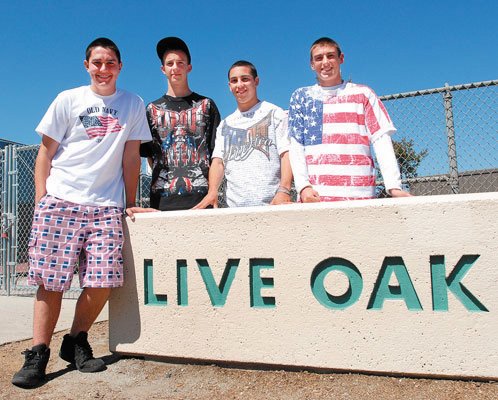The controversial ruling over the 2010 Cinco de Mayo incident at Live Oak High School is headed to the U.S. Supreme Court.
That’s what attorney William J. Becker has vowed after a three-judge panel of the 9th Circuit Court of Appeals in San Francisco upheld a federal judge’s 2011 ruling last week affirming that school officials acted accordingly when they ordered three former students to remove their American patriotic T-shirts on the Cinco de Mayo Mexican holiday.
“The panel held that school officials did not violate the students’ right to freedom of expression, due process, or equal protection,” reads the official 9th Circuit ruling.
Becker told the Times he first plans to file a petition for en banc review of the three-judge panel’s ruling before an 11-judge panel of the same 9th Circuit Court of Appeals. An “en banc” session is where a case is heard before all the judges of a court, or before the entire bench, rather than by a panel selected from them.
If the next “preliminary” step does not go in their favor, Becker will appeal to U.S. Supreme Court.
“It’s pretty incredible that the First Amendment rights of students to express their patriotic views has to take the backseat to the rights of students who want to celebrate another nation,” said Becker of the Los Angeles-based Becker Law Firm, which represents the families of three former LOHS students involved in the 2010 Cinco de Mayo incident on the school campus.
LOHS senior Connor Rounds, like most of his fellow classmates, was in middle school at the time, but he said some students were talking about what transpired on their campus nearly four years ago.
“I heard some talk around campus. It wasn’t the focus of everyone’s conversations,” said Rounds, a member of the varsity basketball team and the Associated Student Body. He added that he agreed with the court’s ruling and the principal’s decision since “he did what he thought was best for the students.”
MHUSD Superintendent Steve Betando was not with the district at that time, but he provided a statement on the district website in support of the higher court’s decision and actions taken by school administrators on that day.
“We believe the Ninth Circuit correctly determined the administrators must be afforded reasonable leeway to make difficult decisions when necessary to protect student safety, even where such decisions impact student speech,” Betando wrote.
“The District has always maintained that the decisions made by its adminstrators on that day had nothing to do with favoring one group over another, but rather stemmed from a motivation to protect the safety of the student-plaintiffs and the other 1,100 students on the Live Oak campus.”
Betando’s predecessor, Former Superintendent Wes Smith, agreed.
“I applaud the Ninth Circuit Court of Appeals for unanimously holding that school administrators can intervene to ensure student safety before students are physically harmed,” Smith said.
Co-counsel Robert Muise argued on behalf of the LOHS students during oral arguments back on Oct. 17, 2013. He said the wearing of American T-shirts by the students was a “silent, passive, peaceful way” to protest and a form of pure speech.
Cinco de Mayo is a celebration to commemorate the Mexican army’s unlikely victory over French forces at the Battle of Puebla on May 5, 1862. In Mexico, it is only celebrated by people in the state of Pueblo. In the United States, it is a day to celebrate Mexican heritage and pride.
But in 2010, the celebration turned ugly on the LOHS campus when Mexican students felt disrespected by four Caucasian classmates wearing patriotic American T-shirts. Those boys were sent home after refusing to remove the shirts or turn them inside out. Former LOHS principal Nick Boden and former assistant principal Miguel Rodriguez – neither currently with the district – said they were concerned about the potential for violence on campus. Neither the fourth student, Austin Carvalho or his parents, joined the suit.
“If the court believed that there was a record of past disruption on the high school campus, then the solution would have been for the school to cancel the Cinco de Mayo celebration, not to deprive patriotic students their guaranteed First Amendment right of free speech,” added Becker, touching on the basis for the three-judge panel’s decision.
The panel reasoned that “given the history of prior events at the school, including an altercation on campus, it was reasonable for school officials to proceed as though a threat of a potentially violent disturbance was real.”
The court documents detailed the previous incidents.
“Live Oak had a history of violence among students, some gang-related and some drawn along racial lines,” the court documents read. “In the six years that Nick Boden served as principal, he observed at least 30 fights on campus, both between gangs and between Caucasian and Hispanic students.”
Detailing Cinco de Mayo in 2009, the year prior, a group of Caucasian students “hung a makeshift American flag on one of the trees on campus, and … began clapping and chanting ‘USA.’”
One Mexican student, among a group carrying the Mexican flag, then shouted “f*** them white boys, f*** them white boys,” according to the court documents.
“When Assistant Principal Miguel Rodriguez told the student to stop using profane language, the student said, ‘But Rodriguez, they are racist, They are being racist. F*** them white boys. Let’s f*** them up.’”
“The behaviors and student interactions at Live Oak High School on Cinco de Mayo in both 2009 and 2010 were clear signs that the threat of a potential disturbance was real,” Betando wrote. “The court found that school officials made a justifiable decision to intervene in the interest of student safety.”
The decision to send the students home in 2010 sparked a media frenzy nationwide on a debate on First Amendment rights in newspapers, talk shows and television news as the story went viral, including on the front page of foxnews.com, The Drudge Report and MSNBC. Bay Area news stations set up camp in front of the LOHS campus.
“That was kind of an isolated thing that popped up and, obviously, isn’t indicative of Live Oak at all,” said current LOHS principal Lloyd Webb, who has been with the district since 1995. “We have a very peaceful, very diverse campus where the kids get a long very well.”
On May 6, 2010 nearly 200 mostly Hispanic teens from LOHS and Sobrato high schools marched through downtown Morgan Hill escorted by police to support Mexico, bearing Mexican flags and attire. Video footage can still be viewed online today, giving a first-hand account of the hostilities of that time.
However, other LOHS students from various backgrounds united to show their solidarity among any suggested racial tensions after the incident. Webb confirmed that the multicultural group, called “Student Voices,” was formed shortly after the incident and still exists, promoting unity and inclusion on campus.
“The group brings together students from a wide range of ethnicities and cultures,” Webb said. “They have their hands in a lot of things to help with school culture.”
In 2010, LOHS Vice Principal Auri Yabrudy was a LOHS classroom teacher, teaching Spanish to native speakers. She discussed the incident with her students in the days that followed and “the kids were very positive,” she said. “They just wanted to put an end to this.”
District officials said there have been no incidents on campus during any of the three Cinco de Mayo holidays after the 2010 altercation. Two of those years, however, the Mexican holiday fell over the weekend.















